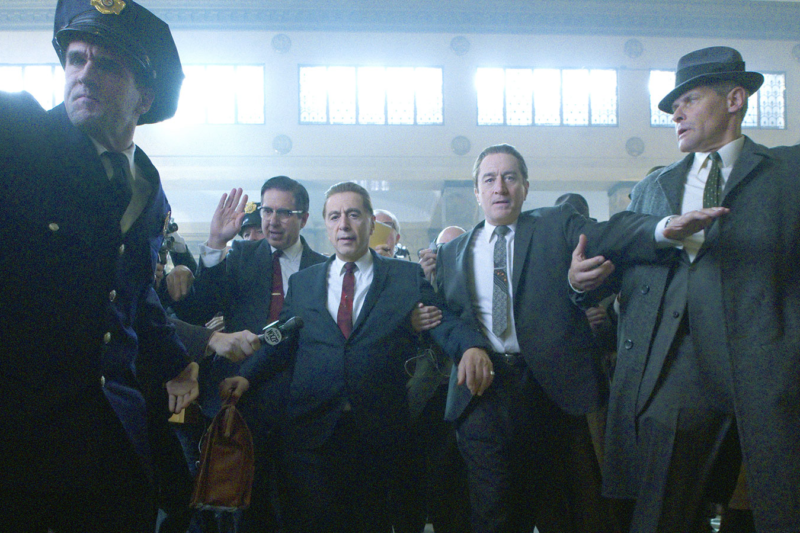The Remarkable Power of “The Irishman”

When, several years back, word got out that legendary director Martin Scorsese had optioned the rights to direct a film version of I Heard You Paint Houses by Charles Brandt, I could hardly wait.
First, because I was vaguely familiar with the book but looked forward to the master filmmaker Scorsese’s treatment of it. And second, because although my father was only a rank-and-file member of one of the New York–area labor unions that figure prominently in the story of The Irishman, I vividly remember the names of many of the major characters at our dinner table during the 1970s and 1980s.
Spanning 60 years, The Irishman chronicles the life of Frank Sheeran (Robert DeNiro). As a truck driver returning to Philadelphia after World War II, DeNiro’s Sheeran quickly finds out that selling goods off the back of his truck is more lucrative than making the actual deliveries. One thing leads to another, he finds himself in a tight spot, and at the cost of a few favors he becomes an adoptee of northeastern Italian/Sicilian mob organizations. The Forrest Gumpian journey touches everything from the rise of Las Vegas to the Bay of Pigs, the assassination of JFK, and the power struggle over the Teamsters union.
With the advice of his friend and advisor, Philadelphia mob kingpin Russell Bufolino (Joe Pesci), Sheeran rises in the ranks, eventually becoming a close friend and confidant of Jimmy Hoffa (Al Pacino). Hoffa, of course, ran the International Brotherhood of Teamsters for nearly 15 years and, in what has become a perennial cause célèbre, disappeared in 1975. Over the decades, Sheeran develops a reputation for professionalism and loyalty, and ultimately faces dilemmas which inform the essence of all drama: conflict.
There are some interesting shifts of role in this film. Pesci, who perennially appears in Scorsese’s gangster films, is neither the hair-trigger, unstable Tommy DeSimone he portrays in Goodfellas or the especially vicious Chicago–Las Vegas enforcer Nicky Santoro (allegedly based upon Tony “The Ant” Spilotro) from Casino. As Bufolino, he’s uncharacteristically soft spoken, yet no less ruthless. And Al Pacino, notoriously prone to cringeworthy overacting, is as controlled as he has been since he portrayed Carlito Brigante in the most underrated film of the 1990s, Brian De Palma’s Carlito’s Way. I admit to having been somewhat skeptical about him as Hoffa, but that doubt was misplaced.
The intimidating length of the film, coming in at just over 3 ½ hours, does no harm: it probably wasn’t necessary to make it that long, but it flew by nevertheless. Less successful were the much-touted CGI “de-aging” effects. Yes, the digitization creates a Sheeran younger than the currently 76-year-old DeNiro in the flashbacks to the 1940s and 1950s. But it certainly did not create a 20-something Sheeran, as was hoped for.
Filmmakers tend to peak early in their careers, and Scorsese is no exception. While solid, and even great, The Irishman is not Scorsese’s magnum opus; at this point it’s all but certain that the 1990 Goodfellas will hold that appellation.
Although based upon the 1985 Nicholas Pileggi book Wiseguy: Life in an American Mafia Family (which has, in my view, a vastly superior ending), Goodfellas ends with Henry Hill relocated in the witness protection program, ordering spaghetti and marinara sauce (and getting “egg noodles and ketchup”), and “liv[ing] the rest of his life as a schnook.” Sam Rothstein, Chicago bookmaker-cum-casino executive, returns to handicapping football.
Although not in the gangster realm, The Wolf of Wall Street sees former chop shop brokerage baron Jordan Belfort out of a brief stint in a minimum-security prison, back to plying his fundamental skill: selling. For all of these characters, termination of the arc finds the character in some state of overall equilibrium: wiser, well-travelled, but not especially worse off than where they began. Yet Sheeran sees no such cathartic denouement: he languishes in an old-age home, contemplating his life, but with little remorse. In one of the final scenes, with the same stoicism he brought to discharging his murderous duties, he shops for his own coffin — a luxury afforded to none of his victims.
A sinister intimation of the film comes in a briefly told yet critically important flashback. Sheeran was a World War II veteran. And while the fawning admiration of all-things-World War II (curiously popular among the Baby Boomers, who seem to have outgrown their 1960s antiwar sensibility) tends to focus on notable events like the D-Day landings or the Battle of the Bulge, less attention is given to others. Sheeran, for example, participated in the Italian Campaign, a lesser-known, brutal slog up the Apennine Peninsula that resulted in some of the highest infantry casualties in the entire European theater of operations. While most troops reportedly saw an average of 100 days of combat, Sheeran’s unit saw over 400. He also reported taking part in several atrocities, including executing enemy POWs.
Indeed: conspicuously absent from this film are the standard Hollywood portrayals of hitmen who, pointing a weapon at their trembling quarry, launch into seething monologues or taunt them with jaunty catchphrases. Scorsese’s Sheeran chooses his weapon the way a mechanic (unsurprisingly, another colloquialism for assassin) or dentist would. He stalks his prey, erupts into a two- to five-second homicidal maelstrom — and departs. He is, as he was back in Europe, following orders and discharging his duties with complete dispassion.
America is bogged down in a 20-year war in Afghanistan, ongoing interventions in Syria and Yemen, and who knows what else, where else — by one account over 40,000 troops are engaged in military operations which the United States government will not disclose the existence of, let alone detail. A recent dimension in our conversion to an ossified global empire features a president actively intervening to protect war criminals. Hardly a day goes by — certainly no major holiday or sporting event does — where American military personnel aren’t breathlessly thanked for their service. Frank Sheeran — “The Irishman” — is the dark, shattered underbelly of that service.










